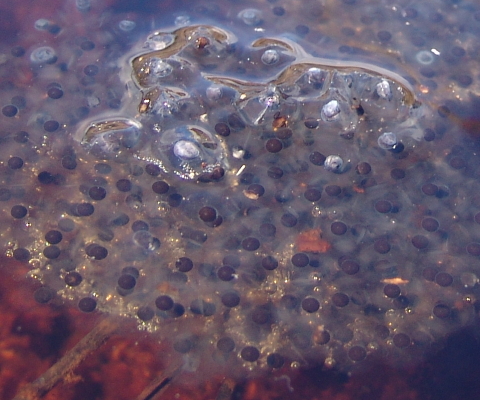Yellow Spotted Salamander (Ambystoma maculatum) Egg Sac
A light rain sprinkled the South Coast of Massachusetts on Friday night with temperatures still hovering in the high 30s/low 40s. We had not yet seen any sign of spotted salamander mating congresses and no egg sacs so far this season because temperatures have been unfavorable. In fact, we experienced an April Fool’s Day snow storm this year. Nothing to write home about, only a couple of inches of heavy flakes, but still enough to delay the kick start to spring. Even frogs and spring peepers have been few and far between. The wild seems eerily silent this year.
Spotted Salamander Individual Egg
After last night’s gentle rain, Turtle Journal opted to scour the shallow channels of Marion’s abandoned Goldwitz Bog this morning, and we found a small concentration of spotted salamander egg sacs in the very early stage of development. Obviously, since it was broad daylight, we saw no spotted salamander specimens.
Development of Spotted Salamander Eggs and Larvae
Combining original Turtle Journal footage from last season with material from Yale University in 1920, the video clip above documents the development phases of spotted salamander eggs. The eggs we found today in the abandoned Goldwitz cranberry bog, as pictured above, are clearly at early stages of development. You can read about last year’s nighttime adventure to discover the spotted salamander mating congress under Turtle Journal articles “Slithering Salamanders, Turtleman! Why Did the Spotted Salamander Cross the Road?” and “Portrait of a Spotted Salamander.” (ASIDE: Fortunately, you won’t have to read about how the Turtleman got a permanent “dueling” scar across his nose while scrambling through the bog’s thorny bushes in the dark of night.)
Spotted Salamander Egg Sacs in Goldwitz Bog
Today’s egg sacs were in the same approximate location of last year’s mating congress, although much, much fewer in number. We expect to see more mating activity over the coming nights, especially if there’s any warm rain in the forecast.
Close Up of Spotted Salamander Egg Sacs
Above our camera zooms in on the only egg sacs that we discovered today, April 2nd.
Close Inspection Show Early Developmental Stage of Eggs
And the camera zooms even further to show the eggs/embryos in early stages of development.
Extreme Close Up of Individual Egg Sacs
With an extreme close up of individual egg sacs, and comparing them to the video above, you can clearly see how early in the development process these larvae remain. We suspect … based on our continuing observations of this area … that the eggs may have been deposited last night, April 1st/2nd.
Entire Eco-System Springs to Life
Sometimes we forget how important these events are to the entire eco-system as colonies of interesting critters erupt around salamander and frog mating aggregations, a magical time on the South Coast when the entire bog springs to life and to sound. We leave you with a trilling chorus of “A Little Amphibian Night Music” … an original creation by the Slithering South Coast Croakers.






